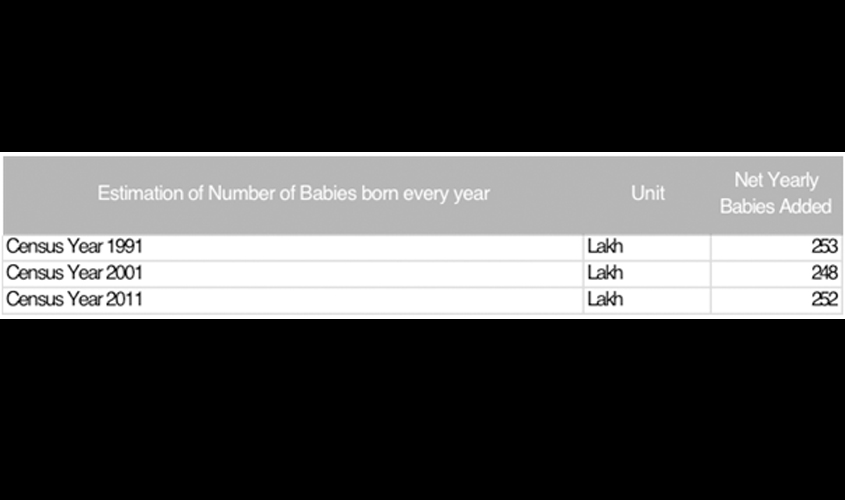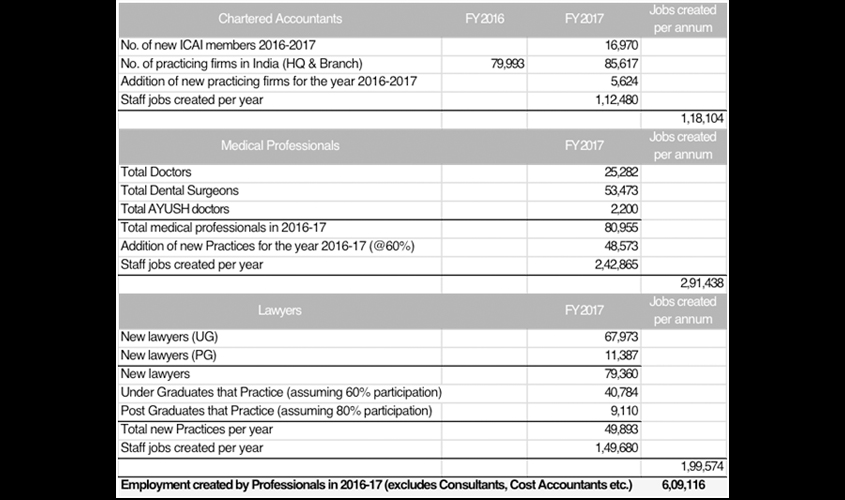New Delhi: There are no comprehensive reports detailing job creation in India. Numbers for formal sector employment have been arrived at for the first time in the “Towards a Payroll Reporting in India” report by Prof Pulak Ghosh of the Indian Institute of Management, Bangalore and Dr Soumya Kanti Ghosh, Group Chief Economic Adviser of SBI. The predecessors to the Ghosh Report were NSSO reports that, through their estimates, did not adequately represent the employment situation in the country. Thus emerges the need to develop a better mechanism to determine and report the job situation in the country.
A good place to start is analysing the supply of human capital in the jobs market. Taking into consideration the data from the Census of years 1991, 2001, and 2011, the Ghosh Report reveals that 2.5 crore babies are born every year. Consequently, 2.5 crore people attain the age of 21 annually today and will do so for the next 20 years as well.

Labour participation rate among these 2.5 crore people is estimated at about 60%, i.e. 1.5 crore people enter the labour force every year. Further, the AISHE (All India Survey on Higher Education) report for 2016-17 highlights that the total number of graduates that pass-out in the country each year is around 88 lakhs. Within this demographic, the drop-out rate (not wanting a job) can be approximated at around 25%, helping us determine the incremental number of qualified people added to the labour force annually, ~66 lakh. Non-graduates as a proportion of the labour force would then come in at 84 lakh.

Jobs, by definition, are split into the formal and Informal sectors in India. Formal sector jobs are characterised by Social Security coverage. Social Security in India is provided by three organisations: EPFO, ESIC, and NPS (NPS is specific to government employees). The best sources of data for Formal job creation are the EPFO and ESIC, which cover a gamut of 190 and 90 industries, for those employing over 20 and 10 employees, respectively. The data for the last six months has been released by EPFO and ESIC and has been analysed thoroughly in the Ghosh report. As of March 2018, their findings revealed that 55 lakh incremental jobs have been registered with the EPFO, 9 Lakhs with the ESIC, and 7 lakh with the NPS. Therefore, a total of 71 lakh jobs have been created in the formal sector according to incremental Social Security coverage in 2017-18. This data has been well construed and will only see nominal changes with better data coverage as 2018 progresses. It is, however, safe to assume that the formal sector generates close to 70 lakh jobs a year as this data is based on monthly contributions and payroll.

We must also look at members of the population outside the scope of Social Security. Job creation among professionals like chartered accountants, lawyers and doctors is key in generating employment, and needs to be an integral part of our calculations. According to ICAI (Institute of Chartered Accountants of India) data, there were 16,970 new Chartered Accountants added to the job force in 2017 with around 5,624 new practices setting up shop. The total number of jobs created by this segment of the population is a factor of additional human resources employed by the professional for setting up a new practice.
This applies to doctors and lawyers as well, with both adding approximately 80,000 to the labour force in 2017. Summing up ancillary staff members (clerks, paralegals, nurses, etc.) required to set up practices by these professions, we have surmised that over 6 lakh jobs were contributed through just these three professions in the Informal sector, with employment figures for other similar professions and consultancies not considered.

Further, the total stock of employment created through these three professions is around 1.08 crore, assuming 20 jobs per CA practice, 5 jobs per Medical practice, and 3 jobs per law practice as per the below table.

The skill development initiatives of the government under the Pradhan Mantri Kaushal Vikas Yojana and National Skill Development Corporation provide the data as outlined below. They have successfully generated 5 lakh jobs in the previous year but may have been considered in other categories in the formal or informal sector accounting.

The transport industry generates a large chunk of informal employment, made up of individuals or small firms owning vehicles. Data available from Society of Indian Automobile Manufactures (SIAM) is segregated by the types of vehicles, providing us sales and exports numbers across the commercial vehicles, three wheelers, and passenger vehicles categories. The capacity for employment for each of these vehicles can be assumed at around 2 per commercial vehicle, 1.5 per three-wheeler, and about 0.25 (1 in every 4 cars) for every passenger vehicle. Following this premise, it can be surmised that the transport sector contributes close to 20 lakh jobs per year, a figure often overlooked by employment surveys and reports. These jobs would be in the Informal sector as these vehicles are typically owned individually and not by firms. This is buttressed by the fact that the EPFO and ESI data do not reveal these jobs in any large measure.

Commercial vehicles in India—trucks, LMV (goods), LMV (passenger), buses, and taxis—typically generate 2 jobs per vehicle. The cumulative stock of these in 2016-17 was about 2.25 crores. Therefore, the stock of jobs within the transport industry was extrapolated to be around 3.6 crores in India today.


The contribution to informal jobs creation is a factor of many other sources beyond the scope of this analysis. However, for the sake of brevity and reasoning, we have estimated that employment not covered by social security from professional and transport sectors alone contribute about 29 lakhs per year. Cumulatively, from the Formal and these Informal sectors, India generates over 1 crore jobs each year. This is an understatement as several informal sectors and MSMEs are not considered in this extrapolation. A complete picture of the employment scenario can only be achieved through the use of big data analytics over improved information reporting standards. In this article, we restrict ourselves to only a few organised chunks of professionals and to the transport sector to determine an objectively conservative flow of employment for the year.

Further, the total active labour force in India is estimated in various studies to be around 50 crore (estimated based on NSSO 2012). As per the World Bank, agriculture contributes to the creation of around 43% of these jobs, thus bringing the workforce in Industry and Services to around 28.5 crore. Of this, we can quite conservatively appropriate that 9.5 crore are in formal employment as per the below table, placing India as the third largest Formal employment generator in the world after China and the US.

If we take jobs generated in the transport sector and through professionals, the number adds up to about 4.7 crore. This means that the other uncovered sectors in the Informal sector employ the balance of 14.3 crore, requiring periodic adjustments for unemployment through surveys.

This analysis elucidates the fact that India does not, in fact, have a job creation problem, but a wage problem. Low wages (of about INR 15-20K per month), especially in the informal economy, do not allow the Country’s citizens to live a comfortable and productive life. Efforts need to be directed towards greater job formalisation, including increased social security coverage and better data gathering so that appropriate policies can be made.
It is important to note that India does not face a problem of not possessing the data to drive at its employment disposition. The right data is lying with the government, the authors of the Ghosh report have demonstrated that a planned approach of using “Payroll Reporting” can be used to unclutter this data and provide accurate and invaluable insights.
Most importantly, this incontrovertible data proves that claims of jobless growth are completely unfounded and totally wrong. The Indian economy has grown significantly between 1991 to 2018 at the rate of 8.7% a year from USD 275bn to USD 2.6Tn. Such growth cannot be jobless growth. Further, India’s current GDP growth rate of 7.5% per annum would most certainly contribute towards a job growth rate of at the very minimum, 2.5-3% per year. As our Prime Minister said, we need better jobs data so that the focus is on good policy directed at creating more formal jobs rather than empty rhetoric about jobless growth.
T.V. Mohandas Pai is Chairman, Aarin Capital Partners. Yash Baid is Head of Research, 3one4 Capital.

